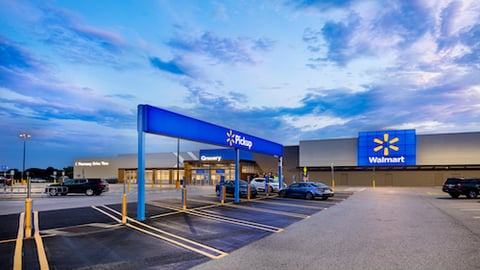Walmart Testing Stores as Online Fulfillment Centers
Hoping to better serve online shoppers, Walmart is testing using stores as online fulfillment centers, a reflection of logistical trends in the larger world of retail.
In a blog post, John Crecelius, SVP of associate product and next-generation stores, Walmart U.S., said that “we’re moving quickly to use our physical retail stores to not only serve in-store shoppers, but to flex to meet the needs of online shoppers, too, in ways that only Walmart can. That’s where our new test stores come in. Their purpose is to find solutions that help our stores operate as both physical shopping destinations and online fulfillment centers in a way that has yet to be seen across the retail industry.”
According to Crecelius, Walmart has identified four stores across the country to serve as test centers, where “we will continuously rotate new technology, digital tools and physical enhancements in and out of the stores, all with the intention of helping our associates better and more easily serve our customers. We have two up and running, with two more to come.”
Crecelius didn't identify the stores.
“To increase the speed at which we learn, product and technology teams will be embedded in the stores to prototype, test and iterate solutions in real time, scaling what works and scrapping what doesn’t, creating a true rapid prototype environment,” he said, adding that some of the what the retailer will test will be visible to customers, while some won't be.
He offered these examples of what the retailer will test:
- Omni-assortment: Not everything stocked in stores today can be found online. “In our first test store,” he said, “we’re moving most of the in-store apparel assortment online, and we will continue to identify other hard-to-manage categories that we can work to make available. By doing so, we’ll learn what it takes to make all eligible items in the store truly omni-available for customers online and in the store.”
- Inventory speed: Crecelius said that Walmart recently developed an app that speeds up the time it takes to get items from the back room to the sales floor. “Instead of scanning each box individually,” he wrote, “associates just hold up a handheld device, and the app uses augmented reality to highlight the boxes that are ready to go. Product gets on the shelf faster – something we all know is increasingly important.”
- First-time pick rate: According to Crecelius, the retailer is currently testing how it can use a combination of in-store signage and handheld devices to help employees navigate to the right locations when picking items for an online order. “So far, this simple change has reduced the time it takes our associates to find the items,” he said. “In fact, the percentage of times associates find the item on their first attempt has gone up by 20% in some of the categories that tend to be our hardest to pick. What this means for customers is that their orders get filled faster.”
- Checkout experience: These stores will continue to build upon a new experimental checkout experience that Walmart introduced earlier this year to help transform a transactional experience into a relational one. “We will continue to test different hardware and software solutions focused on enhancing, and even reimagining, a contact-free checkout experience for customers,” Crecelius said.
Bentonville, Arkansas-based Walmart operates more than 11,300 stores under 58 banners in 27 countries, and e-commerce websites, employing 2.2 million-plus associates worldwide. Walmart U.S. is No. 1 on The PG 100, Progressive Grocer’s list of the top food and consumables retailers in North America.





